#beyhan sultan daughter of selim i
Text
Mistakes in Magnificent Century part I
In part I I would like to speak about mistakes they made while writing characters. Their ages, titles, origins etc.
Let's start with Ayse Hafsa Sultan:
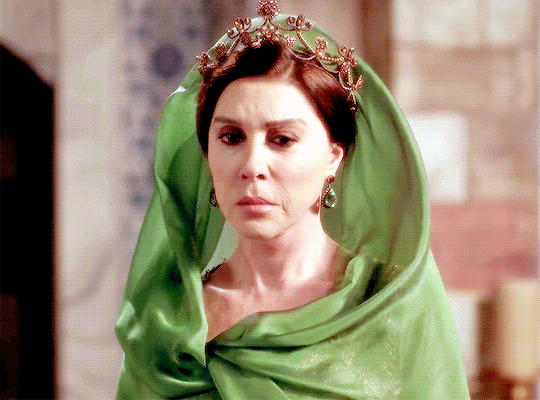
Several things about her were done wrong. First of all, She was not Crimean princess. There are two possibilities that although contradicts one another counters her royal origin. 1. There was another concubine named Ayse,who was daughter of Crimean khan, while she was called Ayse Hafsa for that reason 2.( I agree with that possibility more ) there was no concubine from Crimean family Sultan Bayazid would never let Selim, who was not his favourite, to gain such allie, nor would khan of Crimea risk to marry her daughter to non-favoired prince. Besides, Selim did not have much of a support from Crimea during his Rebellion.
As we more or less agreed that Ayse Hafsa was not Crimean, now we have to agree on where she was from. Legendary mother of the Magnificent sultan was actually converted slave of Caucasian origin, therefore she was either Circassian or Georgian.
Third thing about her is her title. Screenwriters both demoted and promoted her in this case. She was not "Valide Sultan" as we know today, first holder of that title would be Nurbanu 40 years after her death. She was Sultan and respected mother Padisah yes,but those two honours never joined for her. She was simply " Mother of Sultan Suleiman",who had title of Sultan instead of Hatun. While Nurbanu was full fledged "Valide Sultan" and was addressed so. Despite not being Valide Sultan, she was the first slave in Ottoman history, who was elevated to Status of Sultan that was never underlined in the show.
Other mistakes about her are how they represented her pre-1520 life, which I will discuss in Part 3 about "Titles, ranks and traditions" and her relationship with daughters- in law, that will be discussed in part 2, that will be specifically about relationships.
2. Ages of Suleiman's sister.

In the show Suleiman Seems to be older, followed by Sah or beyhan, Fatma being somewhat middle and Hatice as baby of the Family, while actually going backwards. One thing I want to make clear is that all the full sisters of sultan were older than them(before 1522 of course), half sister could have been either younger or older. So Fatma, Beyhan and Hatice despite being portrayed as younger sisters were definitely older. A more accurate sequence would be:
Hatice- c. 1490
Fatma: 1491-92
Beyhan: most likely 1493
Suleiman: 1494
Hafsa: 1495
Sah-huban: 1500
Suleiman also had at least three brothers orhan, salih, who seemed to be older than Suleiman, a sister who likely died during childhood and Shehzade sultan or Hanim sultan, who was either another sister or perhaps she never existed and all the little sources about her is actually about hatice.
3. Origin of Sah Huban Sultan.

She was not the daughter of Hafsa and older sister of Hatice, she was actually the youngest of shown siblings,born as the only child of an unknown concubine registered as " The mother of Sah Huban Sultan".
4. Origin of Hurrem

In the show she was portrayed to be Crimean and was addressed as " Russian slave" numerous times. However, she was actually from Ruthenia, it was then part of the Polish crown, now it's part of Ukraine, so definitely not Russian.
5. Forgotten Children
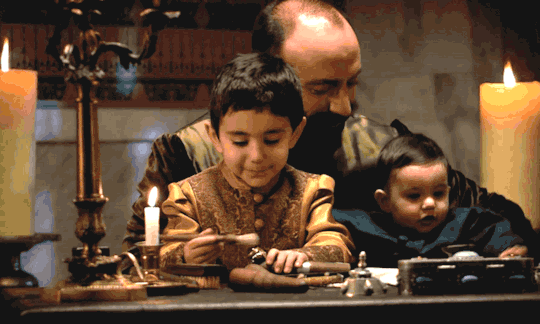
Apart from the six children that were shown in the show, Suleiman had four other children. Three sons and a daughter.
Shehzade Mahmud and Shehzade Murad were born before Hurrem arrived and had different mothers. Mahmud was the eldest born in 1512, Murad was younger than Mustafa born in 1519. Raziye was born between 1513 and 1518, but most likely she was born in 1513-14 as she seems to be the second child and old enough to be considered Mahidevran's(which is by the way false). All three of them died in 1521 as the result of the plague.
The fourth child Shehzade Abdullah was born as the fourth child of Hurrem and Suleiman, born in 1525 and died in 1528. His date of birth is kind of troubling, some historians argue if he was born in 1525,some even say he was Mihrimah's twin, but considering no birth of twins registered, definite ages of other kinds and his appearance in Hurrem's letters Abdullah seems to be born in 1525.
6. Nurbanu's Triplets

Mistakes about the birth of Selim I daughters are more or less clear, let's speak about Selim II as well.
In the show, triplets- Sah, Esmahan and Gevherhan were introduced as younger twin sisters of shehzade Murad. In reality, all three were older but certainly not twins, Sah was not even Nurbanu's daughter, she shared the birth year with Gevherhan though, both were born in c.1544, then was Esmahan in 1545, Murad in 1546, at this point Nurbanu stopped giving birth to any more kids, last of Selim II's kids was Fatma born in 1559.
7. Origin and death of Gulfem hatun
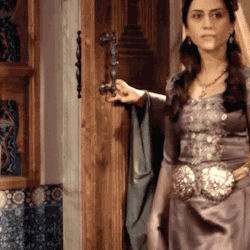
In "Magnificent century" Gulfem is portrayed as Suleiman's first concubine, who bore a son,but lost everything after he died. In reality, Gulfem was one of the highest ranking harem managers, whom Suleiman trusted Hurrem to, she was overseeing her education and well-being, bonding with future Haseki Sultan in the process. Gulfem actually became the closest friend and Confidant of Hurrem, about which I will speak about in part II.
Her death was also portrayed inaccurately. She was not killed for the attempted murder of Suleiman, The closest rumor to it is him executing Gulfem for rejecting him,but she actually died of old age. Suleiman had no reason to execute Gulfem,there is a version were Gulfem exchanges her Night to other concubine to for money to build complex,but there are so many flaws in this theory:
1. There was no such thing in harem as "my turn and your turn"
2. It was strictly against the traditions to call harem servant, especially one from the highest ranks, and considering when it happened in kate nineteen-early twentieth century at caused some probmens,which means tradition was never broken before
3. Gulfem had right to send concubine to Suleiman and even reject one already chosen.
4. Suleiman had no known concubine that time
5. Gulfem was not building anything as all of her projects was already finished.
6. Even if she was building something, it would cost so much mere concubine would never have enough money to help it. Gulfem's daily stipend was 150 akches, which is almost four times as much as Mahidevran's and almost as much as imperial princesses', while titles concubines were receiving 1-6 depending on their status.
7. Even if she needed something she would ask it to either Suleiman, Mihrimah or Sah huban as we know it had happened before and they thought her as family member.
8. Even if we just jump these 7 reasons and somehow accept that Suleiman realy called her that night , he would never kill her for that, she broke no rule, she needed money for project, he would understand this.
9. Gulfem was childhood friend of Suleiman, she was already a high ranking woman when mahidevran came,so she was certainly older than her,who was likely born in 1498-99, she was even older than Suleiman most likely. She was a childhood friend of one of Suleiman's sisters so her date of birth could vary from 1490 to 1493. That would make her between 69 and 72 in 1562. Dieing at such age is nothing strange even today, live past 60 was actually achievement in her era. There is no need to look for intrigue where there is none. Several theory existed,but show chose most dramatic one,that happened to be least likely.
8. Safiye's arrival

I have nothing against the portrayal of her origin, but about how she got in Murad's harem. Accord- ing to MC she was Mihrimah's gift. However,in real life she was raised and educated at Humaşah sultan's court,who later gifted Sifiye(then called Meleki) to her cousin.
9. History of Kösem

In Magnificent Century Kosem young Anastasia was kidnapped as a gift of Safiye to Ahmed per his accession. Actually, Kösem, then called Mahpeyker, was a servant of Handan Sultan and met Ahmed in his mother's personal Gardens. Ahmed developed a "Childhood crush" towards her and Handan,aware of what it could cause, had Kösem beaten up and exiled. When Ahmed ascended her recalled her and brought back.
10. Another forgotten child.

In the show, Şehzade Mehmed died without any kids, while in reality, he had a posthumous daughter born in 1543 named Humaşah. Who grew up to be one of the most powerful women in the Ottoman empire. She was one of two favourite grandchildren of Suleiman and Hurrem and due to the death of her father, she was raised in the household of her grandmother, so she would have been deeply involved in their later life. However, her existence was completely cut out, while the role and importance of Ayse Humaşah, daughter of Mihrimah Sultan was reduced into nothingness.
#history#16th century#historical drama#magnificent century#magnificent century kosem#mc: kosem#medieval women#hurrem sultan#kosem sultan#safiye sultan#nurbanu sultan#gulfem hatun#sultan suleyman#ottomanladies#ottoman history#ottoman#ottoman empire#ottoman sultanas#historical figures#historical events#haseki hurrem sultan#ayse sultan#valide sultan#historical fiction
164 notes
·
View notes
Text
kehribar-sultan: Well thakns four your appreciation, yeah, I really tried hard......But, first I would like to say some words about your comment: 1) I would like to get your acceptance and recognition of possibility that Safiye had all of these four daughters. I would stress out that ambassadors only talked about children of the Topkapi Palace who were notable in political life (case with Murad IV’s four full sisters). I do not agree with you, Ahmed Pasha (Mirahur in 1604) was named governor of Rumelia two times; firstly in 1614 and secondly in 1614. And he wasn’t Aga of the jannisaries. The Pasha you’ve mentioned is someone else. Beside, I found in Dumas’s 2013 book that Mihrimah was same as Mihriban (page 82, note 171). Anyway, she died in early 1610s I quess, and her husband remarried to her half-sister Fahri Sultan in September 1613. Anyway, I suggest that Mihrimah was the eldest, as I proved in citations that Mehmed had a two years older sister than him. Also, I (most strongly) suggest that Hümaşah was Safiye’s daughter, even the youngest, as her husband Hasan Pasha was placed in Divan of Ahmed I, and he referred to her as halem. 2) I didn’t get your comment about suggested (officially unknown) sons-in-law of Murad III, such as Boyali Mehmed Pasha, Siyavush Pasha (failed) and Serdar Ferhad Pasha. I mean, all that marriage negotiations in early 1590s prove that Safiye had more than two daughters. 3) I would suggest that Murad III’s daughters Saime and Fahri were his longest-living daughters, who died in late reign of Mehmed IV (Hümaşah, Beyhan and Hatice died in early reign of Mehmed IV). Anyway, I need to stress out that Fahri’s full name was Fahrihan (source: https://www.isam.org.tr/uploads/6595588ee2276.pdf - page 494 ; also there is Saime too – page 138) 4) I have suspitions that Murad III had one more daughter named Asüde Sultan, but I won’t claim it until I am sure it was his daughter.
I’m sorry if my answers are lacking but it’s just a lot of information to process fast and sometimes I get lost in the labyrinth of Ottoman princesses.
I never said Safiye couldn’t have been their mother. I said that since both Mihrimah and Hümaşah were important people in Murad III’s life, if he ever wanted to honour them he would have done it with his eldest daughters, hence Safiye’s.
I do not agree with you, Ahmed Pasha (Mirahur in 1604) was named governor of Rumelia two times; firstly in 1614 and secondly in 1614. And he wasn’t Aga of the jannisaries. The Pasha you’ve mentioned is someone else
Oh sorry, I copied my notes into the ask. I couldn’t understand what you were talking about until i saw my note in brackets lol. I thought it was him because Öztuna says that Mirahur Ahmed Pasha was, among other things, Janissaries commander and then governor of Rumelia:
=Dâmâd Mîrâhûr Ahmed Paşa (ölm.Ist.1618), izd.21.2.1613, izd.müd.5 yıl. Enderun, çukadâr 1612, hâsodabaşı, mîrâhûr 1613, yeniçeri ağacı 10.1613, vezâret'le Rumeli beyl.2.1614, Şâm 1617-8, mâzûl
I think I’m starting to see why you say that Mihrimah was Safiye’s eldest daughter. It took me a long time (bc i’m stupid) but I’m starting to see the light lol. If Matteo Zane is correct, and this princess was 26 years old in 1592 then there was definitely another daughter of Safiye who, for some reason, was unmarried at the time. If Mihrimah is Murad III’s eldest child then he definitely wanted to honour his beloved aunt (whom he honoured again when she died, burying her next to Süleyman).
I do agree that Hümaşah seems to be the youngest daughter of Safiye.
So, basically, Safiye’s children could be:
A princess (Mihrimah) born in 1564 circa
Mehmed III, born in May 1566
Süleyman, born in 1568-69 (the Venetians say he was two years younger than Mehmed) (he must have died before 1576, when another Süleyman was born)
Ayşe, born in 1569-70
Mahmud, born in July 1572
Fatma, born in 1574
Süleyman, born in December 1576 (and died in 1577)
Selim, born in December 1578
Hümaşah, born in 1580 (?) (though Sakaoğlu says she was born in Manisa)
Öztuna says that a Şehzade Mustafa was born in “1578?” and a Şehzade Osman was born in “1573” in Manisa. Osman was the eldest after Mehmed and died in 1587. Mustafa was executed by Mehmed III in 1595 and was the prince Canfeda had tried to save before being dismissed. Unfortunately Pedani didn’t source this claim, I would have loved to know more about this. These two princes though do not figure in “A COMPARISON OF SEYYID LOKMAN’S RECORDS OF THE BIRTH, DEATH AND WEDDING DATES OF MEMBERS OF OTTOMAN DYNASTY (1566-1595) WITH THE RECORDS IN OTTOMAN CHRONICLES”, so I don’t know. On the other hand, Karaçelebizâde says that the eldest prince executed by Mehmed III was born in 1585… which would make more sense.
Considering that Safiye was sent away to the Old Palace in 1583 and that the Venetian ambassador already reported that she could not have any more children (”seeing that she got ugly and could no longer have children”, dispatch dated 18 September 1583), I’d say that Hümaşah was the latest child she had (or maybe she had a miscarriage/difficult birth afterwards which sealed her condition). Selaniki, on the other hand, says that a 2yo princess died on 29 July 1585… maybe she was Safiye’s last child?
I didn’t get your comment about suggested (officially unknown) sons-in-law of Murad III, such as Boyali Mehmed Pasha, Siyavush Pasha (failed) and Serdar Ferhad Pasha. I mean, all that marriage negotiations in early 1590s prove that Safiye had more than two daughters.
Sorry about that!! So, I didn’t say anything because I thought that what you said made perfectly sense; I had nothing to add. I googled Ferhad Pasha and Wikipedia said that he tried to escape execution by appealing to Safiye. Unfortunately there is no source but it would make sense if he was her son-in-law. Where did you find that Nişancı Mehmed Pasha was governor of Rumelia in 1591? I swear I can’t find it anywhere.
I would suggest that Murad III’s daughters Saime and Fahri were his longest-living daughters, who died in late reign of Mehmed IV (Hümaşah, Beyhan and Hatice died in early reign of Mehmed IV). Anyway, I need to stress out that Fahri’s full name was Fahrihan
Saime stops being mentioned by Ragusian diplomats after 9 August 1670, while Farhi or Fahrihan (which I really like) is mentioned until 9 May 1679 as “Pahari” (unless it’s someone else but that’s the last time someone with a similar name was mentioned).
I’m going to read about Asüde Sultan soon, I’ve seen your message in my inbox :D
8 notes
·
View notes
Text

~VALIDE AYŞE HAFSA SULTAN~
She was the favorite consort of Sultan Selim I. Following the one concubine mother -one son policy she gave birth to three daughters Hatice, Fatma, Beyhan and a son Süleyman (Süleyman the magnificent). She was very loved by people, her master, her childern and the whole harem. To express his love to his mother, Sultan Süleyman gave her the Valide Sultan title, before that, Valides were addresses as Valide hatun. Thus, she became the first slave origin woman having the title "Sultan". Her exact date of birth and origin are unknown,she bay be from black sea regiok but she was definitly NOT the crimean princess, daughter of Mengli Giray. Hafsa Sultan was the first slave origin consort able to build a imperial mosque (Sultan Mosque in Manisa). She died on 19th March 1534 in Istanbul. She rests in Yavuz Sultan Selim's Mosque.
youtube
#youtube#hafsa sultan#ayse hafsa sultan#ottoman empire#sultan suleyman#valide sultan#history#ottoman#Youtube#Spotify
12 notes
·
View notes
Photo






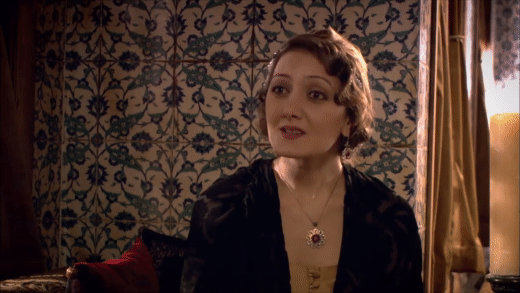
Sisters in Muhtesem Yuzyil
Row 1: Fatma Sultan and Sah Huban Sultan
Row 2: Esmahan Sultan, Gevherhan Sultan and Sah Sultan
Row 3: Hatice Sultan and Beyhan Sultan
#Sister#Sisters#muhtesem yuzyil#magnificent century#fatma sultan#sah huban sultan#hatice sultan#beyhan sultan#sah sultan#gevherhan sultan#esmahan sultan#historical drama#historical tv#historical characters#historical sisters#period drama#period dramas#daughters of selim I#Daughters of Selim II#sultana#born sultana#born sultanas#born sultans
26 notes
·
View notes
Text
Süleyman & Sisters - Headcannons
- We never learn what the exact order of siblings is in the show, and it sure as hell isn’t the same as in history, otherwise I would have to believe Selma Ergeç is older than Halit Ergenç, which... NO. In my interpretation, Beyhan is the oldest, Süleyman is the second, Şah the third, Hatice fourth and Fatma the youngest.
- Hafsa, Şehzade a Gevherhan may still exist, but have different mothers than Süleyman. Şehzade and Gevherhan are much younger than Süleyman, so they don’t interact much. Hafsa is a year younger just like in history, but during childhood he interacts with her less than he does with his full-blooded sisters and after she marries, they grow apart completely. Şehzade and Gevherhan are still little girls when Süleyman leaves for Manisa, and after his ascention they live in the Old Palace untill marriage.
- Beyhan is the wise older sister that is mostly above it all and oh-so-much mature than her siblings. As a teenager, she hates Fatma, because she’s the only one whose shenanigans can penetrate her façade and either make her laugh or genuinely piss her off.
- Şah is close in age to Süleyman and there is this intense rivalry between them for their mothers’ affections. Because of this, despite receiving less impressive education from her tutors than her brother, she ends up knowing more than him at a younger age, just out of spite. Later, she becomes the smug intellectual of the group, and Hatice and Fatma think she’s a lame nerd.
- Hatice is the big softie who just wants to get along with everyone, and all of her sisters love her for that, except for Şah, who thinks she’s the lame one.
- Fatma is the baby of the family, spoiled by the whole family, untill she grows up into a hyperactive prankster. Sometimes, she is the most annoying kid in the world and Beyhan even jokes at her wedding that at least she’s getting away from Fatma.
- Süleyman is the favourite child of Ayşe Hafsa, both because he is Selim’s precious heir and because he’s her only surviving son. Selim, on the other hand, absolutely adores Şah, which is probably what kickstarts their increasingly bad relationship.
- Fatma’s first prank was during a celebratory dinner at Beyhan’s wedding, which leads to Ayşe Hafsa personally spanking her. This leads to a feud between her and Selim’s mother, who knows this is decidedly not a proper way to raise royal children.
- Şah used to have a massive crush on Ibrahim, that’s true, but she was, like, seventeen and in the she grew out of it pretty quickly. Namely when her new husband showed her his massive library.
- Fatma married that old dude from the beginning of season 4 was against her will, and for the first few years he spent a lot of time “visiting” (read running away to) her siblings, even half-sisters. She was forbidden from coming to Istanbul, however, because she was just that annoying, and the only reason she came back eventually was because Süleyman in his old age just forgot how annoying she can be.
- All of the girls were taught needlework as part of their education, but only Beyhan and Hatice kept it as a hobby untill adulthood. Şah gave up on needlework after Beyhan kept bragging about how much better she is at it, so Şah, unable to best her, came to the conclusion that needlework is stupid anyway. Fatma was never into it in the first place.
- Süleyman has drank wine several times in his life. Beyhan drinks wine exactly once, and that is at Süleyman’s prompting when visiting him at Manisa. Hatice does so several times when married to Ibrahim and every time she thinks she will like it, but doesn’t, so she’s mad at Ibrahim for giving her the idea. Fatma is of course the vodka (or rather raki) aunt of the family, that’s practically cannon. Şah has never drank a single drop of alcohol, because she’s the Good Muslim (tm) of the family and judges all the rest of them filthy heathens.
- Selim had several sisters, and they sometimes come to visit him and his family. Everyone dreads their visits, because they are super judgemental and hate Ayşe Hafsa for reasons that completely escape the kids.
- Ayşe Hafsa actually gets along pretty well with Selim’s mother, and his kids adore grandma. Unfortunately, she dies before Selim becomes a sultan. Fatma is her favourite grandchild and becomes extremely emotional at her funeral, inappropriately so, which Ayşe Hafsa writes off as just her making a scene for attention. In the end, only Hatice is able to console her.
- When Beyhan is a little kid and Şah just a toddler, she thinks Şah’s full name being long is the funniest shit ever, and can’t stop intentionally mispronouncing it. Süleyman agrees and sometimes joins her. Then three year old Şah starts to correct them, but at first she mispronounces it too, just unintentionally. Eventually, Beyhan stops thinking it’s funny, but it takes a while for Süleyman to catch on. Before that, he gets smacked by Şah several times for making fun of her name.
- Selim buys all of his daughters horses and tries to teach them how to ride. They are universally terrible at it, though it takes a while for Hatice to admit it, because she loves her horse and wants to be around it.
- Hatice as a little girl gets along with animals in general. When she’s five, she gets a cat as a gift from her dad, a Turkish angora. She names it Süleyman, loves it to bits and when the cat dies of old age, she is devastated and vows to never own any other cat. Fatma sometimes jokes that the reason she loves Ibrahim so much is because he reminds her of that cat.
26 notes
·
View notes
Text
Non real life sultanas
A little Christmas surprise post comes. One of my most popular videos on Youtube was the one, where I gathered non-historical characters, explaining how fictional or how historical they were, and if there was a real historical person behind them as an inspirer. Now, for Christmas, I would like to summarize for you the main fictional characters of the Muhteşem Yüzyil series.
Several fictional characters were present in the Muhteşem Yüzyil series, many from the very first minutes. The presence of some fictional characters was forgivable, as we were left with very little detailed information about the harem of Sultan Suleiman I. Thus, for example, the characters of Sümbül Agha, Gül Agha, Mercan Agha, and other eunuchs, although not portraying historical characters, were necessary for the dramaturgy of the series. Sümbül's character was the most important among the eunuchs and perhaps this is why many of us may think that Hürrem actually had such a close friend in the person of the chief eunuch. However, this is not true. During Suleiman's reign, many chief eunuchs took turns, and none of them were known to be particularly close to Hürrem. Of Hürrem's close servants, only one is known by name, a woman named Nevbahar. The characters of Nigar Kalfa, Gülsah Hatun, Fidan Hatun, Daye Hatun, Fahriye Kalfa were similar to Sümbül. None of them were historical, but surely every sultana had their own trusted servants, as they showed in the series. Like the eunuchs and kalfas, the concubines of Prince Mustafa and Prince Bayezid, Ayşe, Rana, Defne or Rumeysa Hatun, can also be considered forgivable fictional characters. We do not know anything about the harem of the two princes as neither of them had a major consort and as their children were born from different women.

However, there were also characters who were written into the story just for the sake of the drama. Which of these characters was acceptable is up to everyone and feel free to write your opinion about them in a comment here or on another platform! So here's the long-awaited list:
Sadika Hatun
Sadika was a Hungarian woman in the series whose husband was killed by Sultan Suleiman on the day of their wedding. Sadika then became the spy of the Hungarian king, Lajos II and she traveled to Istanbul to personally avenge her husband’s death. Matrakci Nasuh Efendi then, by chance, meets the girl and helps her get into the harem, where she immediately joins Ayşe Hafsa Valide Sultan's service and then becomes Hatice Sultan’s chief servant. During her job, of course, she gets close to Suleiman's bed several times, and then she had the opportunity to attack the sultan. However, she does not succeed, Suleiman survives, and Sadika is thrown in the Bosphorus.
In reality, this story would not be possible at all. Even if we assumed that Sadika really existed and Suleiman actually killed her husband, she would not have been able to get into the Sultan's harem and take revenge. On the one hand, Sadika was already a married woman, an adult woman. Such women could not enter the harem, only virgin, child girls could become the sultan's later concubines. However, even if Sadika had somehow been able to get in the harem, a long education would have awaited her before she could join the Valide Sultan's service. While there may have been some exceptional cases where older or non-virgin women wanted to be gifted to the Sultan, these are special cases. Such was the case, for example, when Hayreddin Barbarossa wanted to kidnap the beautiful Giulia Gonzaga, a widowed Italian noblewoman known far and wide, to send her to the Sultan's harem as a gift. In the end, he didn’t succeed, but even if he did, we don’t know if the sultan would had ever taken the woman to his bed.
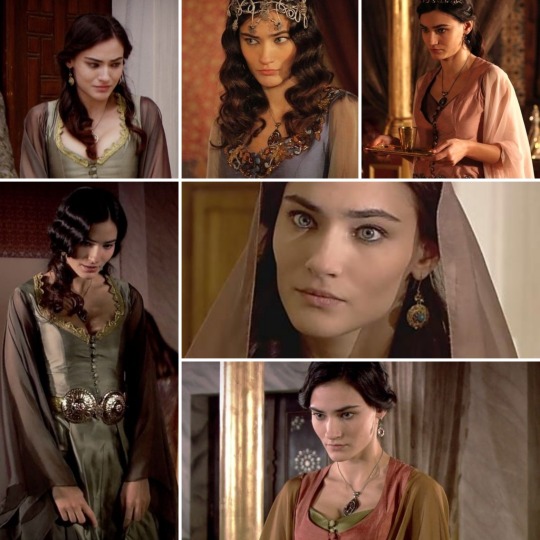
Leo
In the series, he was the love of Hürrem from their youth. Leo came to Istanbul with the goal of finding her former sweetheart. Leo is a talented artist who, with the help of Nasuh Efendi (ahh Nasuh brought all the good people near to the Sultan…) will become the painter of Sultan Suleiman and Pargali Ibrahim. His former relationship with Hürrem will soon be revealed to Pargali Ibrahim, who is thus trying to blackmail Hürrem. Hürrem repeatedly begs Leo to leave the capital, but the man remains, which eventually leads to his death.
In reality, Hürrem - and all the other concubines - were taken into Ottoman captivity as little girls, so it is out of the question that they would have had a love or a fiance. And even if they had, they could never have found them. Nasuh Efendi, though one of the greatest suckers in the series - yet the dearest character - was not like that in reality at all, but he was a wonderful scholar who, by the way, was not so closely friends with either Sultan Suleiman or Pargali Ibrahim.
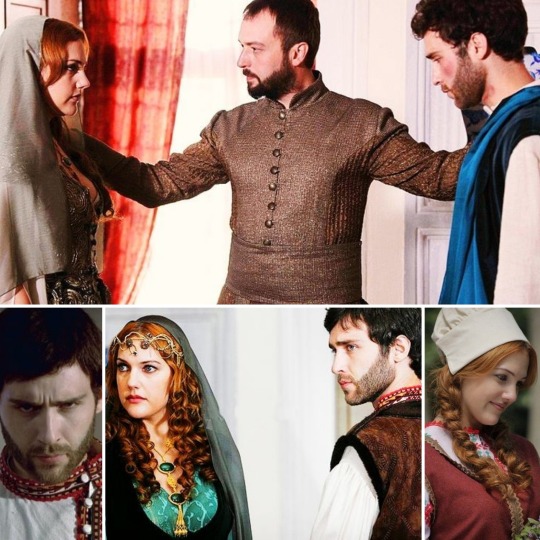
Princess Isabella
Princess Isabella Fortuna was a Spanish noble lady in the series who was on a ship to her future husband, the Austrian prince, when she was captured by Ottoman pirates and was taken to Istanbul to Sultan Suleiman. At first, Suleiman was only interested in the princess for political reasons, but later he fell in love. Princess Isabella initially resisted Suleiman's approach with all her cartilage, but over time she fell in love with the sultan and became his lover. This, of course, Hürrem could not stand and did everything she could to get rid of the princess who was eventually sent home by Suleiman himself.
In reality, of course, such a situation would have been unthinkable. Even assuming that Isabella existed and was captured by pirates, no princess raised in the Catholic faith would have voluntarily become the concubine of a Muslim sultan, she would have committed suicide instead. Let us not forget that Suleiman was loyal to Hürrem from the 1520s onwards, so in reality there was not a single woman who could make hard time for Hürrem during her decades-long relationship with Suleiman. Isabella Fortuna, on the other hand, never existed. Surprisingly, however, they could have patterned her from a real character. There was an Isabella of Castile in this period who was born in 1518 as the child of the widowed Queen of Aragon, Germaine of Foix and Charles V, but she was never captured by Ottoman pirates and was never the bride of the Austrian prince. Isabella's existence was kept secret by her parents all her life, only her mother's testament revealed that she ever existed. It is also known from there that Isabella died young in 1537.
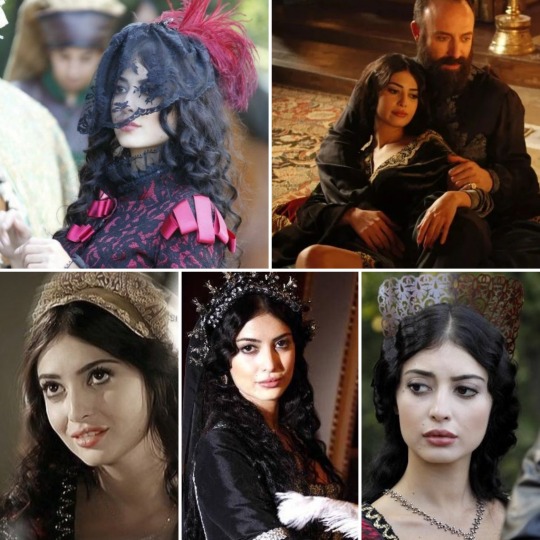
Aybige Hatun
In the series, Aybige was the niece of Ayşe Hafsa, and so the daughter of the Crimean Sahib Giray khan. Aybige originally only came to visit her aunt in Istanbul, but later Hafsa Sultan wanted to see her as the wife of her favorite grandson, Prince Mustafa. However, Aybige was in love with Bali Bey and Mustafa longed for someone else aksi. Bali Bey was eventually almost executed for their love, and Aybige returned to Crimea with her father in the end.
Aybige’s storyline makes mistakes at almost every point. First, Ayşe Hafsa was never the sister of the Crimean khan, so the daughter of the Crimean khan could not have been her niece either. In addition, although Sahib Giray Khan had several daughters, none were called Aybige and none of his daughters ever traveled to Istanbul. The only true point in the whole storyline is that Sahib Giray Khan really collaborated with Sultan Suleiman in his Moldovan war. It is also important to mention Bali Bey at this point. Although Bali Bey was a real historical figure, there is not the slightest match between historical Bali Bey and the series Bali Bey. The real Bali Bey was not a romantic guy who fell in love with every second woman. Bali Bey was a cruel warlord. And if it comes to Bali Bey, let’s say a few words about Prince Mustafa as well. The idea of wanting to marry Mustafa to a khan’s daughter is completely absurd! Since the reign of Sultan Mehmed II, princes have been forbidden to marry anyone, so Prince Mustafa has not been allowed to marry anyone either. And the fact that Suleiman would have supported the idea - even if such a marriage had been able to occurre at all - is an even greater absurdity. Suleiman did not want Mustafa as his heir, so he would never have given him as much power as the support of the Crimean khan.
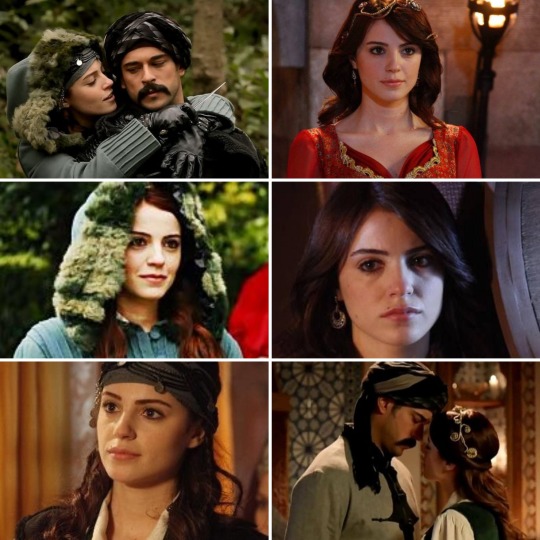
Firuze Hatun
In the series, Firuze was a Persian spy who, with her amazing abilities, was able to heal the pains of the sick Prince Cihangir, earning the love of Hürrem Sultan. Firuze, however, thanked Hürrem kindness in a disgusting way, and became Suleiman's secret lover, whom the sultan fell in love with. In the end, Hürrem was only able to overcome Firuzen with a little, Firuze was eventually exiled from the palace so she could return to Persia.
In reality, Suleiman was loyal to Hürrem, living in a monogamous relationship with her. Even if there was an occasional one-night-stands, Suleiman never fell in love with another woman, only Hürrem. Thus, the Firuze storyline has already failed here. The fact that there was a Persian spy in the harem would have been an interesting suggestion though. There were certainly spies in the royal court of every empire, but they were probably not hiding among the concubines. Eunuchs, for example, moved with much greater freedom, were much better candidates for being a spy…
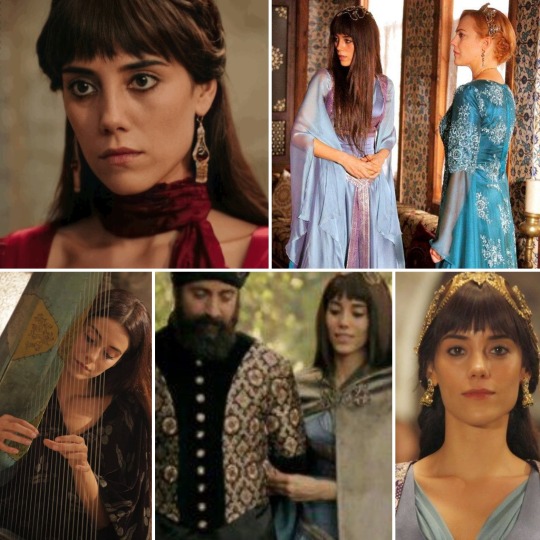
Huricihan Sultan
In the series, Huricihan was the daughter of Ibrahim Pasha and Hatice Sultan, who grew up in the palace of Beyhan Sultan after the death of her parents. From there she returned to Istanbul, where she fell in love with her first cousin, Prince Bayezid. Their love became a relationship and then marriage without the Sultan’s permission. Huricihan became the head of Bayezid's harem and soon her relationship with Hürrem and Suleiman slowly became better. Huricihan's end eventually was brought by Prince Selim's concubine, Nurbanu, who knocked her out in the heat of a dispute, killing her.
In reality, Hatice and Ibrahim Pasha were never married, so they didn't have children either together, so Huricihan never existed. If she had existed, for the reasons already mentioned, it would have been utterly inconceivable for Bayezid to marry her, either secretly or openly. Especially knowing that Bayezid had never had a favourite singled out concubine, as all of his children were born to different women. With a background like this, it’s unlikely he’d ever wanted to marry anyone. Although Hatice Sultan did indeed have a daughter, she was born between 1510 and 1515, so she was well ahead of Bayezid in age, and of course she had nothing to do with the prince and was not even called Huricihan.

Mihrünissa Hatun
In the series, Mihrünissa was the daughter of Hayreddin Barbarossa the Head of the Fleet, whom her father sent to Prince Mustafa as a consultant. Later, the two young person fell in love with each other and married without the Sultan's knowledge. In time, Mihrünissa also gave birth to Mustafa's son Mehmed. After Prince Mustafa and his son Mehmed were executed, Mihrünissa went to the capital and cut her own throat before Hürrem's eyes.
In reality, for the reasons already detailed several times above, no prince could marry anyone, so Mustafa also never married. In addition, Barbarossa never had a daughter named Mihrünissa and Hayreddin Pasha was never a supporter of Prince Mustafa. However, even assuming that Mihrünissa existed, there is no chance that she could have committed suicide before Hürrem's eyes. Prince Mustafa's harem retired to Bursa, so that no member of the harem could travel to the capital, especially not to the palace and kill herself in front of Hürrem. So, in fact, the Mihrünissa storyline was just 100% fiction.
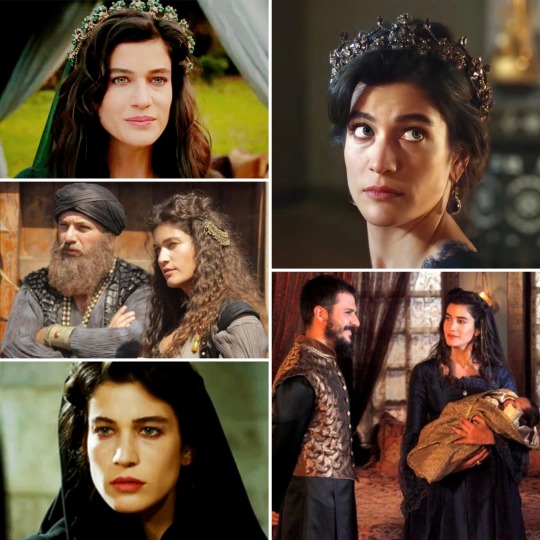
Nazenin Hatun
In the series, Nazenin arrived in Istanbul with Nurbanu, where Hürrem, who was struggling with menopause, sent her to the sultan herself. Nazenin thus became the sultan's concubine and soon gave birth to a daughter, Raziye Sultan. Eventually, on Hürrem's instructions, she was killed by Nurbanu.
In reality, as I have said many times, Suleiman was loyal to Hürrem. In addition, after the birth of Prince Cihangir in 1531/2, Suleiman had no more children, neither to Hürrem nor to anyone else. It is true that he had a daughter named Raziye, however, the child died in 1520 at the age of a few years as a result of an epidemic.
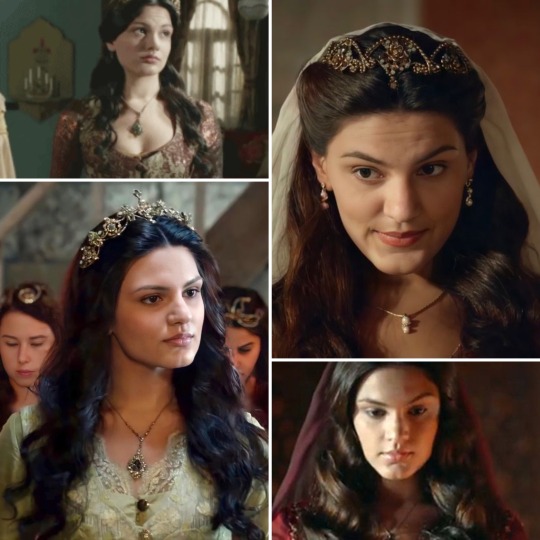
Surprising realities
After many fictional characters, one would think that all eunuchs and kalfas were fictional characters, as we know quite a bit about the harem. However, this is not true! There were some historically inspired characters, such as Gazanfer Agha, who, although existed and was one of the most influential eunuchs ever, was not a loyal man of Nurbanu, but Sultan Selim II. Gazanfer reached the peak of his career, by the way, during the reign of Safiye Sultan.
Similarly historical was Canfeda Hatun, who was Nurbanu’s most loyal servant and one of the most influential kalfas of her era. True, Canfeda’s character in the series was a fusion of two loyal servants of historic Nurbanu. In her young age, in the princely harem of Selim, Nurbanu became acquainted not with Canfeda but with another kalfa, who remained her faithful servant for the rest of her life. Canfeda only became Nurbanu’s main supporter during Selim’s reign.
Like them, Afife Hatun’s character was partly real also. Sultan Suleiman's wetnurse was really called Afife and the sultan always kept in touch with the woman. However, Afife Hatun never moved to Istanbul to rule the Sultan’s harem, but lived a simple life.
Gracia Mendes Nasi was introduced last season as a wealthy Portuguese Jewish woman who helped Portuguese refugees get to Istanbul. Later, Gracia became the lover of Grand Vizier Rüstem Pasha, which made her an enemy of Mihrimah Sultan. In reality, Gracia Mendes was a very benevolent soul who was committed to Jewish traditions and her Jewish brothers. She was never a lover of Rustem and an enemy of Mihrimah. However, like the series, Gracia actually enjoyed the Sultan’s support and, with his help, she made great improvements in Istanbul’s Jewish Quarter and helped many refugees start a new life in the Ottoman Empire.
One of the most interesting guest actors of the last season of the series was Anna Jagello, the daughter of the former King of Poland, the sister of the new King of Poland. Although the woman was a real historical figure, the historical Anna never traveled to Istanbul and never corresponded with Hürrem Sultan. However, Hürrem exchanged letters several times with Anna's mother Bona Sforza, Anna's father, King Sigismund I of Poland, and Anna's brother, the later Zsigmond Ágost II king of Poland, and even Anna's sisterm Isabella, the Hungarian queen. Thanks to the intercession of Hürrem, the relationship between the Kingdom of Poland and the Ottoman Empire was quite good and almost friendly during Suleiman's reign.
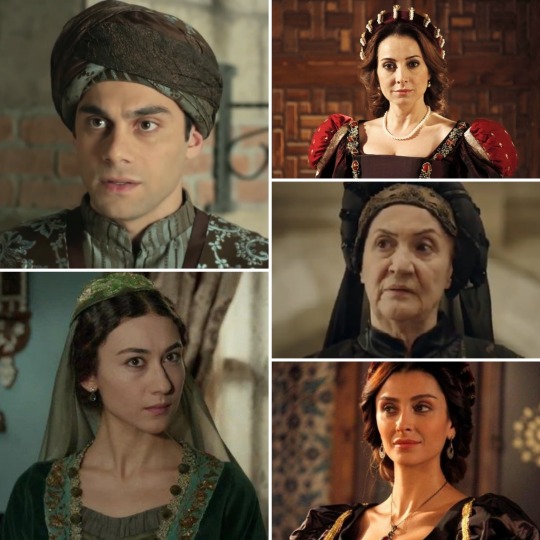
* * *
Egy kis karácsonyi meglepetés poszt következik. Youtube-on az egyik legnépszerűbb videóm az volt, amelyben a nem történelmi karaktereket gyűjtöttem össze, elmagyarázva, mennyire voltak kitaláltak, mennyire volt mögöttük egy-egy valós történelmi személy, mint ihlető. Most karácsony alkalmából szeretném nektek összefoglalni a Muhteşem Yüzyil sorozat főbb kitalált karaktereit és történetüket.
A Muhteşem Yüzyil sorozatban több kitalált karakter is jelen volt, sokan már az első percektől kezdve. Egyes kitalált karakterek jelenléte megbocsátható volt, hiszen nagyon kevés részlet maradt ránk a Szulejmán háremében jelenlévő személyekről. Így például Sümbül Aga, Gül Aga, Mercan Aga és más eunuchok karakterei bár nem valódi személyeket keltenek életre, szükségesek voltak a sorozat dramaturgiája szempontjából. Sümbül karaktere volt a legfontosabb az eunuchok között és talán emiatt sokan gondolhatjuk úgy, hogy Hürremnek a valóságban is volt egy ilyen közeli barátja a fő eunuch személyében. Azonban ez nem igaz. Szulejmán uralkodása alatt rengeteg főeunuch váltotta egymást és egyikről sem ismert, hogy különösebben közel álltak volna Hürremhez. Hürrem közeli szolgálói közül csupán egy ismert név szerint, egy Nevbahar nevű nő. Sümbülhöz hasonló volt Nigar Kalfa, Gülsah Hatun, Fidan Hatun, Daye Hatun, Fahriye Kalfa karaktere is. Egyikük sem valós személy volt, ám bizonyosan minden szultánának megvoltak a saját megbízható szolgálói, ahogy ezt a sorozatban is mutatták. Hasonlóan az eunuchokhoz és kalfákhoz megbocsátható füllentésnek tekinthetőek Musztafa herceg és Bayezid herceg ágyasai is, Ayşe, Rana, Defne vagy Rumeysa Hatun. A két herceg asszonyairól ugyanis semmit sem tudunk, egyiküknek sem volt kiemelt jelentőségű főágyasa, gyermekeik más-más nőktől születtek.

Voltak azonban olyan karakterek is, akiket csupán a dráma kedvéért írtak bele a történetbe. Az, hogy ezek közül melyik karakter mennyire volt elfogadható, azt mindenki maga döntse el és nyugodtan írja meg kommentben itt vagy más platformon, hogy mit gondol róluk! Következzék hát a várva várt lista:
Sadika Hatun
Sadika a sorozatban egy magyar nő volt, akinek férjét az esküvőjük napján megölte Szulejmán szultán. Sadika ezek után a magyar király, II. Lajos parancsára Isztambulba utazott, hogy ott személyesen bosszulja meg férje halálát. Matrakci Nasuh Efendi aztán egy véletlen folytán megismerkedik a lánnyal és segít neki bekerülni a hárembe, ahol azonnal Ayşe Hafsa Valide Sultan szolgálatába áll, majd Hatice Sultan főszolgálója lesz. Menetközben természetesen többször is Szulejmán ágyának közelébe kerül, majd lehetősége nyílik a szultánra támadni. Azonban nem jár sikerrel, Szulejmán életben marad, Sadikát pedig a Boszporuszba fojtják.
A valóságban ez a történetszál egyáltalán nem lenne lehetséges. Ha feltételeznénk is azt, hogy Sadika valóban létezett és Szulejmán valóban megölte a férjét, akkor sem állt volna módjába bejutni a szultáni hárembe és bosszút állni. Egyrészt Sadika férjezett asszony volt már, felnőtt nő. A hárembe nem kerülhettek be ilyen nők, csupán szűz, gyermeklányokból válhattak a szultán ágyasai. Mindazonáltal ha Sadika valahogy mégis bekerült volna a hárembe hosszadalmas oktatás várt volna rá, mielőtt a Valide Sultan szolgálat��ba állhatott volna. Előfordulhatott ugyan néhány kivételes eset, amikor idősebb vagy nem szűz nőket akartak volna a szultánnak ajándékozni, azonban ezek különleges esetek. Ilyen volt például, amikor Hayreddin Barbarossa el akarta rabolni a messze földön ismert, gyönyörű Giulia Gonzagát, megözvegyült itáliai nemesasszonyt, hogy a szultán háremébe küldje ajándéknak. Végül nem járt sikerrel, ám ha sikerrel járt volna is, nem tudni, hogy a szultán valaha is ágyba vitte volna-e a nőt.
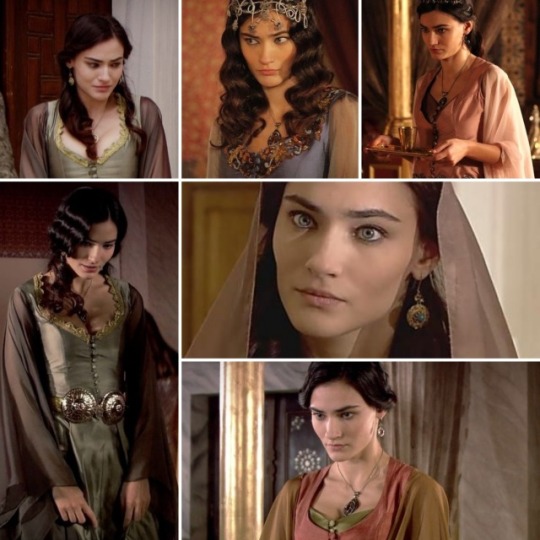
Leo
A sorozatban Leo Hürrem fiatalkori szerelme volt, aki azzal a céllal érkezett Isztambulba, hogy megtalálja egykori kedvesét. Leo tehetséges művész, aki Nasuh Efendi segítségével (ahh Nasuh csupa jó embert juttatott a szultán közelébe…) Szulejmán szultán és Pargali Ibrahim festője lesz. Egykori viszonya Hürremmel hamarosan kiderül Pargali Ibrahim számára, aki ezzel próbálja zsarolni Hürremet. Hürrem többször könyörög Leonak, hogy hagyja el a fővárost, de a szerelmes férfi marad, ami végül halálához vezet.
A valóságban Hürrem – és minden más ágyas – még kislányként került oszmán fogságba, tehát kizárt, hogy szerelmük vagy vőlegényük lett volna, ha pedig mégis, az sosem tudott volna rájuk találni. Nasuh Efendi, pedig aki a sorozat egyik legnagyobb baleke – ugyanakkor legkedvesebb karaktere – a valóságban egyáltalán nem ilyen volt, hanem egy csodálatos tudós, aki egyébként nem állt ilyen közeli barátságban sem Szulejmán szultánnal, sem Pargali Ibrahimmal.
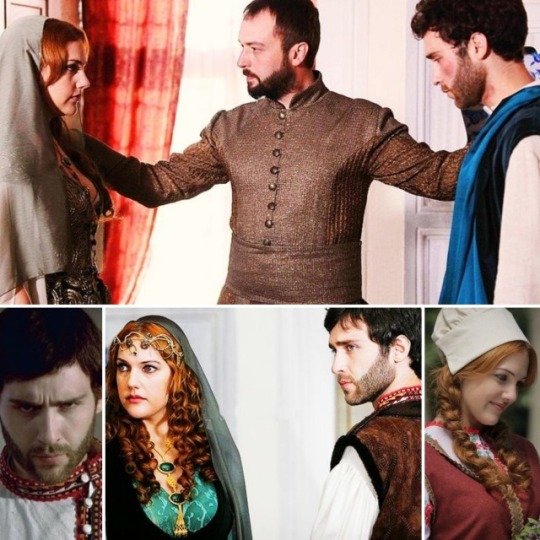
Izabella Hercegnő
Izabella Fortuna hercegnő a sorozatban egy spanyol nemes hölgy volt, aki éppen jövendőbeli férjéhez, az osztrák herceghez tartott hajón, mikor az oszmán kalózok elragadták és Isztambulba vitték Szulejmán szultán elé. Először Szulejmán politikai okokból érdeklődött csupán a hercegnő iránt, később azonban beleszeretett. Izabella hercegnő eleinte minden porcikájával ellenállt Szulejmán közeledésének, idővel azonban beleszeretett a szultánba és a szeretője lett. Ezt természetesen Hürrem szultána nem állhatta és mindent megtett, hogy megszabaduljon a hercegnőtől, akit végül Szulejmán küldött el.
A valóságban természetesen elképzelhetetlen lett volna egy ilyen szituáció. Ha feltételezzük is, hogy Izabella létezett és a kalózok fogságába esett, egyetlen katolikus hitben nevelt hercegnő sem vált volna szabad akaratából a szultán ágyasává, előbb lett volna öngyilkos. Azt se felejtsük el, hogy Szulejmán az 1520-as évektől kezdve hűséges volt Hürremhez, a valóságban nem volt egyetlen nő sem, aki éket verhetett volna közéjük több évtizedes kapcsolatuk alatt. Másrészről pedig Izabella Fortuna sosem létezett. Meglepő azonban, hogy valós karakterről mintázhatták. Létezett egy Kasztíliai Izabella ebben a korban, aki 1518-ban született az özvegy aragóniai királyné Germaine Foix és V. Károly gyermekeként, azonban sosem esett oszmán kalózok csapdájába és sosem volt az osztrák herceg menyasszonya. Izabella létezését egész életében titokban tartották szülei, csupán édesanyja végrendeletéből derült fény arra, hogy valaha is létezett. Innen tudni azt is, hogy Izabella fiatalon elhunyt 1537-ben.
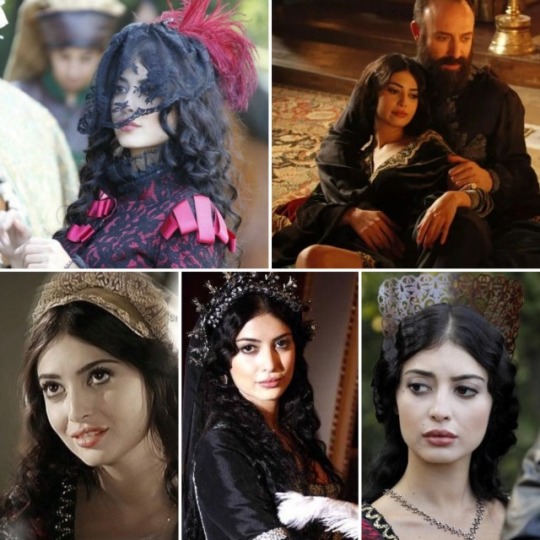
Aybige Hatun
A sorozatban Aybige Ayşe Hafsa Sultan unokahúga volt, a krími Sahib Giray kán lánya. Aybige eredetileg csak látogatóba érkezett Isztambulba, később azonban nagynénje szerette volna őt kedvenc unokája, Musztafa herceg feleségeként látni. Aybige azonban Bali Bégbe volt szerelmes és Musztafa is más után vágyakozott. Bali Béget végül majdnem kivégezték a szerelmük miatt, Aybige pedig apjával visszatért a Krímre.
Aybige történetszála szinte minden létező ponton hibádzik. Először is, Ayşe Hafsa sosem volt a Krími kán testvére, tehát a krími kán lánya sem lehetett az unokahúga. Emellett Sahib Giray kánnak bár több lánya volt, egyiket sem hívták Aybigének és egyik lánya sem utazott sosem Isztambulba. Az egész történetszál egyetlen igaz pontja, hogy Sahib Giray kán tényleg együttműködött Szulejmán szultánnal annak moldáv háborújában. Fontos megemlíteni ezen a ponton Bali Béget is. Bali Bég bár valós történelmi személy volt, de a legkisebb egyezés sincs a történelmi Bali Bég és a sorozat Bali Bége között. A valódi Bali Bég nem egy romantikus fickó volt, aki minden második nőbe beleszeretett, és akiért bolondultak a nők. Bali Bég egy kegyetlen hadvezér volt. És ha már Bali Bég szóba jött, ejtsünk néhány szót Musztafa hercegről is. Az ötlet, hogy Musztafát egy kán lányához akarják adni teljesen abszurd! II. Mehmed szultán uralkodása óta tilos volt a hercegeknek házasságot kötni, így Musztafa herceg sem köthetett senkivel házasságot. Az pedig, hogy Szulejmán támogatta volna az ötletet, már ha egyáltalán felmerült volna egy ilyen házasság, még nagyobb abszurdum. Szulejmán nem Musztafát akarta örökösének, így sosem adott volna a kezébe akkora hatalmat, mint a krími kán támogatása.

Firuze Hatun
A sorozatban Firuze egy perzsa kém volt, aki csodálatos képességeivel gyógyítani tudta a beteges Cihangir herceg fájdalmait, amivel kiérdemelte Hürrem szeretetét. Firuze azonban rút módon hálálta meg Hürrem kedvességét, ugyanis Szulejmán titkos szeretője lett, akibe a szultán halálosan beleszeretett. Végül Hürrem csak egy hajszállal volt képes felülkerekedni Firuzén, akit végül száműztek a palotából, így visszatérhetett Perzsiába.
A valóságban Szulejmán hűséges volt Hürremhez, monogám kapcsolatban éltek. Ha előfordult is alkalomadtán egy-egy egyéjszakás kaland, Szulejmán soha nem szeretett bele más nőbe, csak Hürremet szerette. Így a Firuze történetszál már itt el is bukott. A tény, hogy Firuze perzsa kém lett volna érdekes felvetés, bizonyára akadtak kémek minden birodalom királyi udvarába, azonban ők valószínűleg nem az ágyasok között rejtőztek. Az eunuchok például, sokkal nagyobb szabadsággal mozogtak, sokkal könnyebben lefizethetők voltak…
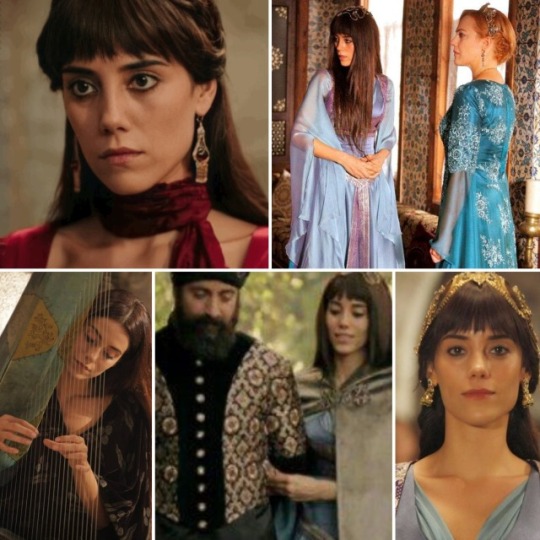
Huricihan Sultan
A sorozatban Huricihan Ibrahim Pasa és Hatice Sultan lánya volt, aki szülei halála után Beyhan Sultan palotájában nevelkedett. Onnan tért vissza Isztambulba, ahol beleszeretett elsőunokatestvérébe, Bayezid hercegbe. Szerelmükből kapcsolat, majd házasság lett a szultán engedélye nélkül. Huricihan Bayezid háremének feje lett és kapcsolata lassanként rendbejött Hürremmel és a szultánnal is. Huricihan végzete végül Szelim herceg ágyasa, Nurbanu lett, aki egy vita hevében leütötte őt, ezzel megölve.
A valóságban Hatice és Ibrahim Pasa sosem voltak házasok, így gyermekük sem született, tehát Huricihan sosem létezett. Ha létezett volna is, a már korábban említett okokból teljesen elképzelhetetlen lett volna, hogy Bayezid feleségül vegye őt akár titokban, akár nyíltan. Különösen tudva, hogy Bayezidnek nem volt sosem kiemelt ágyasa, minden gyermeke más nőtől született. Ilyen háttérrel nem valószínű, hogy valaha is feleségül akart volna venni bárkit. Hatice Sultannak bár valóban volt egy lánya, az 1510-1515 között született, így korban jóval megelőzte Bayezidet, és természetesen sosem volt semmi köze a herceghez és nem is Huricihannak hívták.
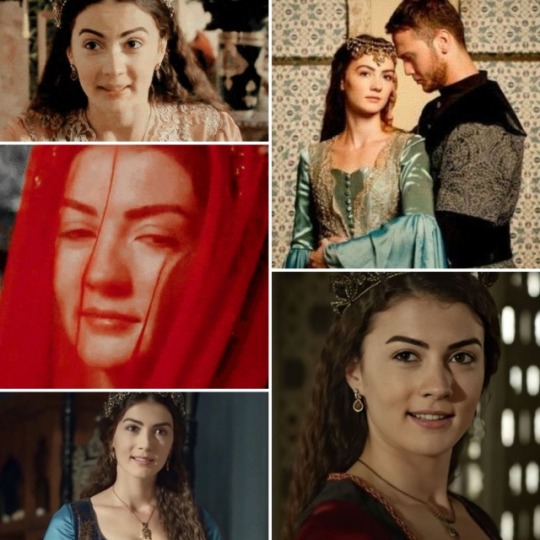
Mihrünissa Hatun
A sorozatban Mihrünissa Hayreddin Barbarossa flotta parancsnok lánya volt, akit édesapja küldött Musztafa herceg mellé tanácsadónak. Később a két fiatal egymásba szeretett és a szultán tudta nélkül egybe keltek. Idővel Mihrünissa életet adott Musztafa fiának, Mehmednek is. Miután Musztafa herceget és vele együtt fiát, Mehmedet is kivégezték, Mihrünissa a fővárosba ment és Hürrem szeme láttára elvágta a saját torkát.
A valóságban a már fent többszörösen részletezett okok miatt egy herceg sem köthetett házasságot, így Musztafa sem nősült meg soha. Emellett Barbarossának sosem volt Mihrünissa nevű lánya és Hayreddin Pasa sohasem volt Musztafa herceg támogatója. Ha azonban feltételeznénk is, hogy Mihrünissa létezett, nincs arra esély, hogy Hürrem szeme láttára lehetett volna öngyilkos. Musztafa herceg háreme Bursába vonult vissza, így a hárem egyik tagja sem utazhatott egyetlen percre sem a fővárosba, nemhogy a palotába, Hürrem elé. Így tulajdonképpen a Mihrünissa történet-szál 100%-ban kitaláció volt.

Nazenin Hatun
A sorozatban Nazenin Nurbanuval együtt érkezett Isztambulba, ahol aztán a menopauzával küszködő Hürrem maga küldte őt a szultán elé. Nazenin így a szultán ágyasa lett és hamarosan egy lánygyermeknek, Raziye Sultannak adott életet. Végül Hürrem utasítására Nurbanu ölte meg.
A valóságban, mint már sokszor mondtam, Szulejmán hűséges volt Hürremhez. Emellett Cihangir herceg 1531/2-es születése után Szulejmán nem nemzett több gyermeket, sem Hürremnek sem másnak. Az igaz, hogy volt egy Raziye nevű kislánya, azonban a gyermek 1520-ban néhány éves korában elhunyt egy járvány következtében.
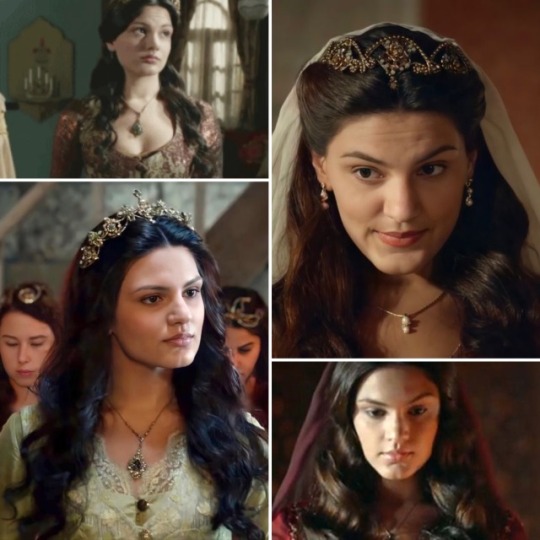
Meglepő valóságok
A sok kitalált karakter után azt gondolhatnánk, hogy az összes eunuch és kalfa kitalált karakter volt, hiszen meglehetősen keveset tudunk a háremről. Azonban ez nem igaz! Volt néhány történelmi ihletésű karakter, mint például Gazanfer Aga, aki bár létezett, és a valaha volt egyik legbefolyásosabb eunuch volt, nem Nurbanu hű embere volt, hanem II. Szelim szultáné. Gazanfer pályája csúcsát egyébként Safiye Sultan uralkodása alatt érte el.
Hasonlóan valós volt Canfeda Hatun is, aki Nurbanu leghűségesebb szolgálója volt és az egyik legbefolyásosabb kalfája korának. Igaz, Canfeda sorozatbeli karaktere, a történelmi Nurbanu két hűséges szolgálójának ötvözéseként született meg. Nurbanu fiatal korában, Szelim hercegi háremében nem Canfedával, hanem egy másik kalfával ismerkedett meg, aki élete végéig hűséges szolgálója maradt. Canfeda csak Szelim uralkodása alatt került képbe és vált Nurbanu fő segítőjévé.
Hozzájuk hasonlóan Afife Hatun karaktere is részben valós volt. Szulejmán szultán szoptatósdajkáját tényleg Afifének hívták és a szultán mindig tartotta a kapcsolatot az asszonnyal. Azonban Afife Hatun sosem költözött Isztambulba, hogy irányítsa a szultáni háremet, hanem egyszerű életet élt.
Gracia Mendes Nasi az utolsó évadban került bemutatásra, mint gazdag portugál zsidóasszony, aki portugál menekülteknek segített Isztambulba jutni. Később Gracia a nagyvezír Rüsztem Pasa szeretője lett, aminek köszönhetően szembe került Mihrimah szultánával. A valóságban Gracia Mendes igen jótét lélek volt, aki elkötelezett volt a zsidó hagyományok és zsidó testvérei iránt. Sosem volt Rüsztem szeretője és Mihrimah ellensége. Azonban a sorozathoz hasonlóan, Gracia a valóságban is élvezte a szultán támogatását és segítségével nagy fejlesztéseket vitt véghez Isztambul zsidó negyedében és nagyon sok menekültnek segített új életet kezdeni az Oszmán Birodalomban.
A sorozat utolsó évadának egyik legérdekesebb vendégszereplője Jagelló Anna volt, az egykori lengyel király lánya, az új lengyel király testvére. Bár az asszony valós történelmi személy volt, a történelmi Anna sosem utazott Isztambulba és sosem levelezett Hürrem szultánával. Azonban Hürrem többször is váltott levelet Anna édesanyjával Bona Sforzával, Anna édesapjával, I. Zsigmond lengyel királlyal, valamint Anna testvérével, a későbbi II. Zsigmond Ágost lengyel királlyal, sőt Anna másik testvérével Izabella, magyar királynővel is. Hürrem közbenjárásának köszönhetően Szulejmán uralkodása alatt meglehetősen jó, szinte baráti volt a viszony a Lengyel Királyság és az Oszmán Birodalom között.
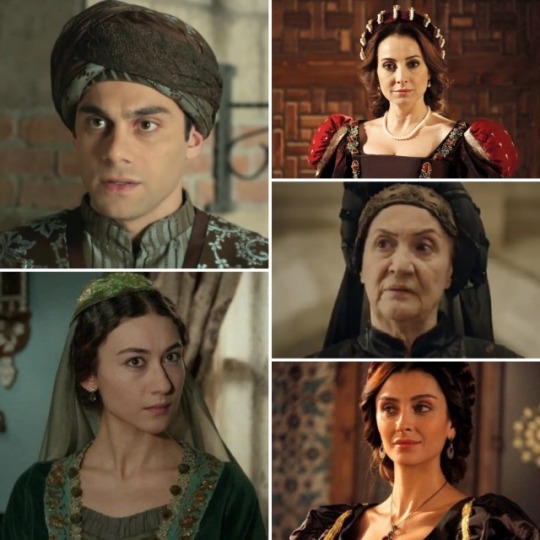
#selim ii#gazanfer agha#gazanfer#suleiman the magnificent#safiye sultan#suleiman i#suleyman i#haseki hürrem sultan#hürrem sultan#nurbanu sultan#aybige hatun#ayse hafsa#ayse hafsa sultan#princess isabella#firuze#firuze hatun
99 notes
·
View notes
Text
❝ ⤚⟶ EUROPE, 1458. thanks is given by the SULTANA MIHRIMAH SULTAN, from THE OTTOMAN EMPIRE. they are at best POLISHED, and at their worst FORCEFUL. whilst abroad, their ambition is to SUPPORT HER OLDER BROTHER AND SEEK A POSITION WORTHY OF HER STATUS AMONGST HER FATHER’S PLANS. SHE seems to remind everyone of BESTE KÖKDEMIR & THE SENSATION OF SILK AGAINST BARE SKIN, THE ROCK OF THE OCEAN SPLASHING AGAINST THE UNDERBELLY OF A SHIP & THE FLUSH OF FEATHERS BEATING AGAINST A GILDED CAGE.❞

and finally… (for now) i offer you the beautiful mihrimah !!
STATS.
full name — mihrimah (persian - ”light of the moon”) sultan (child of the sultan)
titles — sultana of the ottoman empire (imperial princess)
birthplace — edirne, eastern thrace, ottoman territory
age — twenty (20)
languages — ottoman turkish (mother-tongue), arabic (fluent), persian (few dialects), ottoman sign language (fluent), english (learning), french (learning), greek (few dialects)
dynasty — osman
mother — haseki sultan nehir
father — sultan iskender
spouse — n/a
issue — n/a
siblings —
older : unnamed son 🕇
older : melek sultan
older : sezhade of the ottoman empire, heir presumptive
older : sultana of the ottoman empire
younger : ilaldi sultan
younger : ayse sultan
younger : hafsa sultan
younger : emine sultan
younger : sittisah sultan
younger : beyhan sultan
younger : sirin sultan
younger : sehzade kasim
younger : unborn sultan
other —
grandmother : valide sultan mahidevran
aunt : hurrem al-barracin
consort to iskender : consort hiranur sultan
consort to iskender : consort branimira of croatia
brother-in-law : grand vizier rondulu selim pasha
courtier - potential suitor : second vizier yazid ibrahim basturk pasha
harem chief officer : chief steward of the imperial harem
courtier : vadim, wallachian boyar of braila
zodiac — gemini
religious affiliation — islam
face claim — beste kokdemir
height — 5′10″
recognisable features — raven locks that fall way past her shoulders, normally covered by a sheer veil but if you see her hair with your naked eye count yourself blessed.
HEADCANNONS
LIFE IN THE HAREM — it is all she has ever known, to be surrounded by love and women who filled her with an inflated ego, a currency known for her beauty and the dulcet tones fit for a woman of her standing. Due to such an upbringing she did not grow up to hate the woman who tore her father’s attention away from herself and her mother, but loyalty was wedged in deep between muscle and bone! The loyalty she upholds for her mother and older brother know no bounds, and may someday be her undoing if the next Sultan does not carry her true blood.
EDUCATION — Educated well, Mihrimah may have made a good Sultan if she had been born a boy. Nonetheless, she used her feminine whims to her advantage. Though, it is perhaps childish to flaunt such beauty in the eyes of men who see it as all they want. With dance and music, she expresses herself - long, delicate fingers playing to the tune to all who dare to listen. Such culture is praised amongst the women of the palace and the Osman dynasty, but Mihrimah plans to use such skills on many unsuspecting men - to wean out the weak from the strong, to unveil the ones who plan to betray her older brother or her father. She is, in her eyes even, a grand piece to the Sultan’s chessboard - if only he plans to use her more often. Her education has provided her with the gumption to take the reigns of an already crowded steps to the throne, but she does not desire such responsibility as of yet. Instead, she seeks to use her tongue (trained in many a language, that may leave the educated advisers of the Western realms at unease). She plans to take to Portugal as an envoy, to act as her father’s spy if needs will it. Though perhaps a spy is far too generous a word since she is not a coy woman and often boasts of her powers and natural features as if there was not an eye to see it.
MUSIC & DANCE — Though music and dance is a passion well-loved by the Sultana, Mihrimah has always found time and obsession with weaving. Her talent is famous amongst the noble ladies of the Ottoman Empire, and often she will display her woven beauties to the visitors and courtiers who peek with nosey eyes. Back within the palace she rarely took a toe outside, the Sultana has her own rooms lined with her art. She is known for it, but some may whisper that she is doomed to spend her life weaving rather than living - such cruel rumours are only laughed off by the Sultana, even if the question of her future hangs heavy around her neck.
LOYALTY — The loyalty she ties to her older brother is immovable. Such trust was born when the two children grew together, sharing tutors and governesses as they ran through the various halls of various estates. To say she loves him is misunderstood, she adores him. To her, he is her Sultan - above their father, and above their mother. But with such love comes danger; if she is to choose between the two men, who should she lay her allegiance with?
WANTED CONNECTIONS.
friends overseas (pen-pals, frenemies, bffs, the lot!), enemies she may sulk around, boys she commands for her own use, allegiances made for her brother the sehzade, allies she may count on to spread her own influence, and perhaps someone who can take her from simple daughter to wife and consort of the utmost importance.
INFLUENCES.
catherine howard (english history)
bathsheba (the bible)
sirens (folklore)
aphrodite (greek mythology)
grimhild (norse mythology)
ramses (the prince of egypt)
amy (young man with a horn)
the comforters (rudyard kipling)
rachel green (friends)
oberyn martell (game of thrones)
joan holloway (mad men)
amy march (little women)
gabrielle solis (desperate housewives)
jackie burkhart (that 70s show)
buffy summers (buffy the vampire slayer)
lady (lady and the tramp)
tahani al-jamil (the good place)
nala (the lion king)
elizabeth swann (pirates of the caribbean)
daisy buchanan (the great gatsby)
scarlet o’hara (gone with the wind)
lydia bennet (pride and prejudice)
princess jasmine (aladdin)
marie (the aristrocats)
madison li (fallout 3)
blanche (a streetcar named desire)
paula (the winter’s tale, shakespeare)
mihrimah sultan (daughter of suleiman i, history)
#crhs.intro#YES#i finally did it#little late but i wanted it out there#hehe#i. / το τελευταίο έγκαυμα ενός λαμπτήρα ελιάς — study.
8 notes
·
View notes
Note
can you tell us some things about the eight concubines of ibrahim i? thanks a lot, I love your blog c:
thank you so much!!
actually, i don’t really know much about them???
turhan hatice: i talked about her here mother to mehmed iv, fatma and beyhan
saliha dilaşub: potentially his favourite, as she was the only haseki to earn 1,300 aspers??? she hoped kosem and turhan hatice would destroy each other so she could put her son on the throne. when turhan hatice discovered kosem’s plan to dethrone mehmed (which involved putting saliha’s son suleyman on the throne), she exiled her. she only came back when suleyman became sultan. mother to suleyman ii, ayse and possibly to ümmü gülsüm
hatice muazzez: A CUPCAKE. no, seriously. apparently she died of literally fright after a fire in the old palace??? poor babe, she never got to be valide sultan :((( mother to ahmed ii
leyla saçbağli: don’t know anything about her, sorry. according to wikipedia (but let’s not trust it too much) she was the mother of selim, atike and bican
ayşe: nothing. she was mother to murad
mahienver: noooope. mother to osman and kaya
şivekar: apparently ibrahim liked very large women so he sent his men to find the largest in the world and it was şivekar ?? i don’t know if this story is true or not. mother to bayezid and cihangir
hümaşah: the telli haseki, ibrahim’s legal wife. she married ibrahim in 1647 and kosem’s daughters ayse, fatma and hanzade and murad’s daughter kaya were appointed as her servants. apparently her palace was all carpeted in fur??? ibrahim loved furs maybe mother to orhan
28 notes
·
View notes
Photo
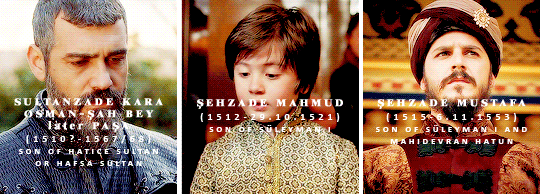

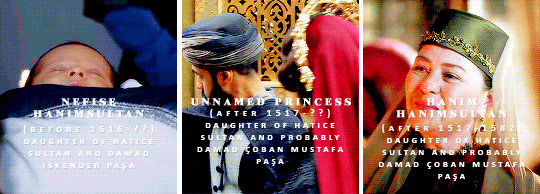

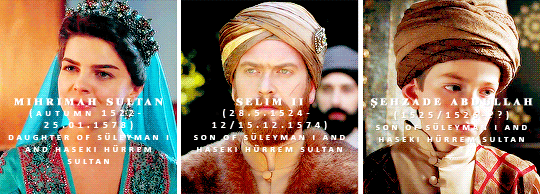
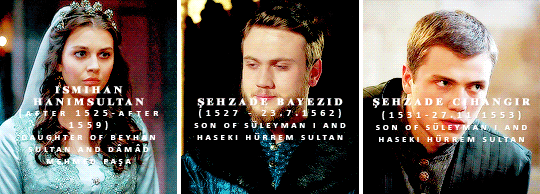
OTTOMANLADIES’ 2ND BIRTHDAY CELEBRATIONS
Ayşe Hafsa Sultan + known grandchildren -- requested by anon
#history#historyedit#ottoman history#ayse hafsa sultan#hatice sultan daughter of selim i#beyhan sultan daughter of selim i#suleyman i#sehzade mustafa son of suleyman i#mihrimah sultan#sehzade mehmed son of suleyman i#selim ii#sehzade bayezid son of suleyman i#sehzade cihangir son of suleyman i#ottomanladiesedit#*requested
620 notes
·
View notes
Note
Can you explain the political marriages between the Ottoman dynasty and the giray dynasty? Some sources claim that Salim's daughter is married to Saadat giray. Can you give me more information about Salim I Harem?
By some sources, I guess you mean Alderson, as he is the only one I could find that says this: un unnamed daughter of Selim I's married Mengili Giray's son and successor, Saadat Giray Han, and had a son with him called Ahmed.

Sakaoğlu doesn't seem to believe this because he could not find any information about this princess, not even when she died or where she was buried.
I have already described Selim I's harem but it's been such a long time and in the meantime I have done some more digging so I am going to talk about it once more.
The harem of Selim I
Consorts
Alderson wrote that he [Selim I] had four wives, three of whom were named Ayşe, Hafsa, and Taçlı Hatun. He claimed that the last one’s name was unknown. Even if he wrote that Ayşe was the daughter of the Crimean Khan, that she was married to Mehmed, Bayezid II’s son, and that Selim married her upon Mehmed’s death at a young age, it is not true. Because we know that during the reigns of Bayezid II and Selim I, Mehmed’s mother and wife were paid and stayed in the Old Palace. According to Hafsa Sultan’s endowment, the woman’s name was Ayşe. Therefore, it is highly likely that Ayşe and Hafsa were the same person. Taçlı Hatun was married at the end of the Çaldıran War to Tacizade Cafer Çelebi. Lütfi Pasha, who participated in this war, described it most clearly in his history. However, even if it is understood from the letters Hafsa Sultan wrote to Yavuz Sultan Selim that Yavuz had other wives other than her, their names cannot be determined. — M. Çağatay Uluçay, Padişahların Kadınları ve Kızları
Ayşe Hafsa Hâtûn (later Vâlide-Sultân): concubine of slave origins, her origins are obscure:
It took the Ottoman populace a long while to discard the assumption that the mothers of princes and princesses were all royally born. This reluctance, present even today, helps to explain why legend has long claimed Suleyman’s mother Hafsa to be a Giray Tatar princess. Hafsa may well have hailed from the northern Black Sea region or even been a gift of the Tatar khan to the Ottoman court, but she was in fact a captive convert of modest origins, like virtually every woman in the imperial harem at the time when she entered it, probably the early 1490s. The tenacious story of Hafsa’s royal Tatar pedigree probably has something at least to do with a different sort of association she enjoyed with the Crimean Khanate. Hafsa accompanied Suleyman on his first political assignment as prince when in 1509 he was appointed, at the age of fifteen, to serve as governor of Caffa. The city was capital of a ribbon of territory running along the southeastern shores of the Crimean peninsula that constituted a province under direct Ottoman rule. In Caffa, Suleyman and his mother doubtless had contact with the Tatar authorities, perhaps with the khan himself. — Peirce, Empress of the East: How a European Slave Girl Became Queen of the Ottoman Empire
She is sometimes called also Hafisa or Hafiza. She was the mother of Süleymân I, Hatice Sultan, Fatma Sultan and possibly Beyhan or Hafsa Sultan. Ayşe Hafsa was the first concubine to receive the title of sultan, therefore making her the first valide sultan. She was also the first woman to build an imperial mosque complex, the Sultaniye in Manisa.
Children
The same mystery that surrounds Selim I's consorts also surrounds his sons. According to tradition, he supposedly killed them all except for Süleymân after he had designated him as heir. Another theory holds that all his other sons simply died in childhood and that Süleymân was the only prince to survive into adulthood.
Süleymân I (27.4.1494/1495 - 7.9.1566): 10th sultan of the Ottoman Empire
Şehzade Orhan (1500?-1510?)
Şehzade Musa and Şehzade Korkut: died little
Alderson instead calls Selim I’s other sons: Abdullah, Murad and Mahmud
His daughters are also a matter of discussion among historians: from their number to their actual names, nothing is set in stone so far.
Gevherhan Sultan (1494?-?): figures only in Öztuna. She married İsfendiyâroğlu Dâmâd Sultân-zâde Mehmed Bey, the son of her aunt Fatma (daughter of Bayezid II)
Hatice Sultan (before 27.4.1494-1582?): Öztuna believes that her second name was Hanım. As Ayşe Hafsa's daughter, she must have been older than Süleymân. Her marriages and children are a matter of speculation:
according to Dumas and Turan, she married Bostancıbaşı İskender Paşa in 1508; widowed in 1515, she married Çoban Mustafa Paşa in 1517. Mustafa Paşa was, for the occasion, elevated to the rank of vizier
That she married İbrâhîm Paşa is a tradition that has long since been dispelled.
With her first husband, she had Sultân-zâde Mehmed-Şâh Bey, Sultân-zâde Süleymân Bey, Sultân-zâde ‘Alî Bey, Nefîse Hanım-Sultân and Sultân-zâde Kara ‘Osman-Şâh Bey/Paşa (1510?-1567/68), though ‘Osman-Şâh is sometimes ascribed to her sister Hafsa. It is not certain if Sultân-zâde Mehmed-Şâh Bey (1525?-?), and X Hanım-Sultân were her children from her second marriage as Mehmed-Şâh was also the name of İbrâhîm Paşa's son with his wife Muhsine Hatun. Hânım Hanım-Sultân is buried in Hürrem Sultan's tomb and called Hatice Sultan's daughter on her plaque. We don't know when she was born but she lived long enough to be married to a Abdü'l-Kerîm Bey.
Fatma Sultan (before 27.4.1494-1556): daughter of Ayşe Hafsa, she had three husbands during her life: Mustafa Paşa, governor of Antalya, but the marriage was dissolved because he was homosexual. Her second husband was Grand Vizier Kara Ahmed Paşa, possibly married in 1532, who was executed on 28 September 1555. Her third and final husband was Hâdim İbrâhîm Paşa, a eunuch, and possibly a love match. She was buried in the mausoleum of her second husband, Ahmed Paşa. All her marriages were childless.
Beyhan Sultan (?-before 1559): if she was Ayşe Hafsa's daughter, she must have been born before 1494. She married Ferhâd Paşa, former chief of the Janissaries and afterwards governor of Rumelia, of Damascus and ultimately second vizier. He was executed by her brother Süleymân I in 1524. She seems to have re-married after 1524, to a Mehmed Paşa with which she had İsmihân Hanım-Sultân. According to Dumas, İsmihân was Ferhâd Paşa's daughter and Beyhan never remarried. Beyhan is also called Peykhan in some harem documents.
Hafsa (or Hafisa) Sultan (1500?-1538?): she was born in Trabzon. According to Uluçay, Ayşe Hafsa was her mother (though this would make her date of birth earlier than 1494). Her first husband was Grand Vizier Dukaginzade Ahmed Paşa, whom Selim I executed in 1515, according to Sakaoğlu. According to Uluçay, she married İskender Paşa, former bostâncıbaşı; Öztuna, on the other hand, claims she had married an unnamed Ağa, and Selim I's bostâncıbaşı. Her second husband is a matter of discussion as well:
Öztuna claims she married Gaazî Çoban Mustafa Paşa (but it seems that he was married to Hatice)
According to Alderson, Dumas and Sakaoğlu, she instead married Boşnak Mustafa Paşa
According to Alderson and Sakaoglu, she had only one son: Sultân-zâde Kara ‘Osman-Şâh Bey/Paşa. Hafsa Sultan died on 10 July 1538 and was buried in the Sultan Selim Mosque.
Şah, Şah-i Huban or Devlet-Şah Sultan (??-1572): daughter of an unknown concubine who resided in the Old Palace as late as 1556, therefore giving credit to Uluçay's theory that Selim I had more consorts other than Ayşe Hafsa but that we lost their names. She married Lutfî Paşa around 1523 and had İsmihân Hanım-Sultân with him. She was a very pious person:
Suleyman’s sister Shah Sultan would prove a prolific patron, although of relatively modest projects (over the course of her long lifetime, she endowed three mosques, three dervish lodges, and other smaller structures in three different Istanbul neighborhoods) — Peirce, Empress of the East: How a European Slave Girl Became Queen of the Ottoman Empire
Her brother Süleymân I granted her a divorce after Lutfî Paşa had tried to hit her:
Shah was wed to the Albanian Lutfi Pasha, grand vizier from 1539 until his dismissal and forced retirement in 1541. The rupture was precipitated by an argument between the couple over Lutfi’s harsh punishment of a prostitute, possibly possibly circumcision or the branding of her genitals. In the heat of dispute, the vizier committed an unpardonable act—he struck his princess wife, grounds for their divorce and his banishment. A notable patron of dervishes, Shah continued to observe her sufi piety through further endowments. — Peirce, Empress of the East: How a European Slave Girl Became Queen of the Ottoman Empire
After her divorce, she did not remarry and instead retired in the Old Palace.
Şehzade or Sultanzade Sultan (??-??): her existence is proven by harem records of the Old Palace, where she figures with her daughter, Ayşe. According to Uluçay, she was married to Çoban Mustafa Paşa but that seems impossible, as Çoban Mustafa Paşa seems to have been Hatice Sultan's second husband. He also says that he died in 1527-28 but he actually died in 1529. Uluçay also called her Hanım.
According to Öztuna, a granddaughter of Selim I firstly married Grand Vizier Koca Sinân Paşa and then married in 1596 Dâmâd Güzelce Mahmûd Paşa, but the marriage lasted less than a year because she died in June 1597. Dâmâd Güzelce Mahmûd Paşa would later become Murad III’s daughter Ayşe’s third husband. Another granddaughter married Pertev Paşa and had a son with him called Ahmed who died before his father. I could not verify these claims but maybe one of these granddaughters was Şehzade's daughter.
#ask post#ask: ottoman history#selim i#ayse hafsa sultan#suleyman i#gevherhan sultan daughter of selim i#hatice sultan daughter of selim i#beyhan sultan daughter of selim i#fatma sultan daughter of selim i#sahihuban sultan daughter of selim i#sehzade sultan daughter of selim i#muhebbbiii
24 notes
·
View notes
Photo







Selim I of the Ottoman Empire + daughters who survived into adulthood
#history#historyedit#ottoman history#selim i#beyhan sultan daughter of selim i#fatma sultan daughter of selim i#hatice sultan daughter of selim i#gevherhan sultan daughter of selim i#hafsa sultan daughter of selim i#sahihuban sultan daughter of selim i#sehzade sultan daughter of selim i#ottomanladiesedit#daughtersof
386 notes
·
View notes
Photo








Hafsa Sultan + children // sources: Leslie Peirce - Empress of the East: How a European Slave Girl Became Queen of the Ottoman Empire, Yılmaz Öztuna - Yavuz Sultan Selim
*the princesses are in alphabetical order because their dates of birth are unknown, it’s only certain that süleyman was the youngest child
#history#historyedit#ottoman history#ayse hafsa sultan#beyhan sultan daughter of selim i#hatice sultan daughter of selim i#fatma sultan daughter of selim i#suleyman i#ottomanladiesedit#childrenof
849 notes
·
View notes
Note
Can you talk about Suleiman's nephews? Are they married to important people in the government? Like Ayşe Hanim Sultan, daughter of Şehzade Sultan, who married koca Sinan Pasha.
This is what I have found:
Sultanzade Osman Bey later Paşa, also called Kara Osman-Şah (1510?- 1567/68): son of Hafsa Sultan and Damad Boşnak Mustafa Paşa. He is sometimes believed to have been Hatice Sultan and Bostancıbaşı İskender Paşa’s son. He was given three principalities in his childhood: Mora, İnebahtı and Thessalia. He lived most of his life in Trikala, which he developed into a major Islamic and cultural centre.
Sultân-zâde Mehmed-Şâh Bey: son of Hatice Sultan and Dâmâd İskender Paşa, uncertain as Mehmed-Şâh was also the name of İbrâhîm Paşa’s son with his wife Muhsine Hatun
Sultân-zâde Süleymân Bey: son of Hatice Sultan and Dâmâd İskender Paşa
Sultân-zâde ‘Alî Bey: son of Hatice Sultan and Dâmâd İskender Paşa
Nefîse Hanım-Sultân: daughter of Hatice Sultan and Dâmâd İskender Paşa
Hânım Hanım-Sultân: daughter of Hatice Sultan, she is buried in Hürrem Sultan’s tomb
İsmihân Hanım-Sultân (?? - after 1559): daughter of Beyhan Sultan and Dâmâd Mehmed Paşa. According to Dumas, İsmihân was Ferhâd Paşa (Beyhan’s first daughter)’s daughter
İsmihân Hanım-Sultân (?? - ??): daughter of Şahıhuban Sultan and Dâmâd Lutfî Paşa, she married one Hüseyin Paşa and had two daughters with him, Neslihan and Vasfihan Hanım
Ayşe Hanım-Sultân (?? - 6.1597): daughter of a daughter of Selim I (maybe Şehzade Sultan). She married Sadrâzam Koca Sinân Paşa (d. 3.4.1596), then second vizier Dâmâd Güzelce Mahmûd Paşa (d. 1604). Mahmûd Paşa would go on to marry Murad III’s daughter Ayşe Sultan
unnamed princess: married Pertev Paşa (d. 1574), according to Yılmaz Öztuna.
sources: M. Çağatay Uluçay - Padişahların Kadınları ve Kızları, Juliette Dumas - Les perles de nacre du sultanat, Yılmaz Öztuna - Yavuz Sultan Selim, Necdet Sakaoğlu - Bu Mülkün Kadın Sultanları
#ask post#ask: ottoman history#suleyman i#hatice sultan daughter of selim i#beyhan sultan daughter of selim i#sahihuban sultan daughter of selim i#sehzade sultan daughter of selim i#makzzsblog
39 notes
·
View notes
Note
Which one of Suleyman's sisters had the happiest fate?
Maybe Fatma? I mean, her life was really miserable but at least in the end she married the love of her life? They were together less than a year, though...
Şahıhuban Sultan was assaulted by her husband but she never remarried after 1541 and instead dedicated her life to religion... maybe she found peace in the end
Hatice is a big question mark after 1515, the date in which her husband was executed. Nothing is known about her after that.
Şehzade Sultan became a widow in 1529, after that she moved into the Old Palace and probably never remarried, as she is listed among the residents there. She was left as trustee of her husband’s foundation
Beyhan Sultan never forgave her brother for executing her husband so I’m pretty sure that she was not the sister who had the happiest fate.
Hafsa Sultan suffered through the execution of her husband by her father, after which she remarried and had children. She died at the age of 38, though, so who knows if she had a happy life with her second husband.
In conclusion, I really do not know which of Süleyman’s sister could have had the happiest life.
#anon#ask post#ask: ottoman history#fatma sultan daughter of selim i#sahihuban sultan daughter of selim i#hatice sultan daughter of selim i#sehzade sultan daughter of selim i#beyhan sultan daughter of selim i#hafsa sultan daughter of selim i
30 notes
·
View notes
Note
Hello, can you list Selim I's harem and children.
Hello! I’m very sorry for being this late but Selim I’s family is a mess. Everything is so confusing and historians do not agree on anything.
Consorts:
Ayşe Hânım/Hatun: supposedly the daughter of Crimean Khan Mengli Giray I. Uluçay doesn’t believe that she was a wife of Selim I’s but that she was instead married to his brother Şehzade Mehmed. According to Alderson, Şehzade Mehmed was her first husband and Selim I her second. Öztuna believes she was the mother of Beyhân and Şâh Sultân
(Ayşe) Hafsa Hatun later Valide Sultan: mother of Hatice Sultan, Fatma Sultan, possibly of Beyhan Sultan and of Süleyman I. (life here)
Children:
Gevherhan Sultan (1494 - ?): married to İsfendiyâroğlu Dâmâd Sultanzade Mehmed Bey, son of Bayezid II’s daughter Fatma. Figured only in Öztuna’s book.
Süleyman I (27.4.1494/1495 - 7.9.1566): 10th sultan of the Ottoman Empire.
Hafsa Sultan (1500 - 10.7.1538): mother unknown, she firstly married Damad Dukaginzade Ahmed Paşa in 1511, who was executed by her father in 1515, and Damad Boşnak Mustafa Paşa in 1522, with whom she had: Sultanzade Osman Bey later Paşa, who was called Kara Osman-Şah. She died on 10 July 1538 and was buried in her father’s mosque.
Şehzâde Orhan (1500 - 1510)
Hatice (Hanım) Sultan (?? - after 1543): Öztuna believes Hanım was one of Hatice’s names and not another princess. Daughter of Hafsa Sultan, she was certainly older than her brother Süleyman, as she married Dâmâd İskender Paşa in 1509. After the execution of her husband in 1515, nothing is known about her life nor when she died.
Beyhan Sultan (?? - before 1559): possibly a daughter of Hafsa Sultan, she married firstly Dâmâd Ferhâd Paşa, a former commander of the janissaries who was executed by her brother Süleyman I in 1524, and secondly Dâmâd Mehmed Paşa, with whom she had Ismihan Hanımsultan, born after 1525. Peirce speaks of children when she talks about Hafsa’s grief over the death of Ferhâd Paşa but doesn’t specify their names. Öztuna was able to find only Ismihan Hanımsultan.
Fatma Sultan (?? - 1556): daughter of Hafsa Sultan and thus older than Süleyman I , she married firstly Dâmâd Mustafa Paşa, governor of Antalya, but divorced him when she found out he was homosexual. She married secondly Dâmâd Gaazî Kara Ahmed Paşa, who was executed by Süleyman I in 1555; and lastly she married Dâmâd Hâdim İbrâhîm Paşa, an eunuch, who was said to have been the love of her life. The marriage lasted only a few months, because Fatma died in 1556.
Şahıhuban Sultan (?? - ??): also called Şah, Şahı, Devlet-Şah, she was definitely not a daughter of Hafsa Sultan because her mother resided in the Old Palace during the reign of Süleyman I (until 1556 at least). She married Dâmâd Lutfî Paşa before 1523 but divorced him in 1541 after he had beaten her up. She did not remarry. Her only known child is İsmihân Hanımsultân; it is not clear whether Sultanzade Ahmed Bey, Sultanzade ‘Abdî Bey and Sultanzade Mahmûd Bey were actually sultanzades or Lufi’s sons from his previous marriage.
(Hanım) Şehzade Sultan (?? - ??): disputed if she really existed or not. She may have been called Sultanzade or Şehzade Sultan, as she figured in privy purse registers from the reign of Süleyman as “Şehzade Sultan” and her daughter, unnamed, as “the daughter of Şehzade Sultan”. She was married to Damad Çoban Mustafa Paşa, who died in April 1529. Her husband built the Çoban Mustafa Paşa Complex in Gebze and left his wife as a trustee of the foundation he created in 1527-1528
Şehzâde Musa (?? - ??): killed/died in infancy
Şehzâde Korkut (?? - ??): killed/died in infancy
According to Öztuna, a granddaughter of Selim I firstly married Grand Vizier Koca Sinân Paşa and then married in 1596 Dâmâd Güzelce Mahmûd Paşa, but the marriage lasted less than a year because she died in June 1597. Dâmâd Güzelce Mahmûd Paşa would later become Murad III’s daughter Ayşe’s third husband.
sources:
Yılmaz Öztuna - Yavuz Sultan Selim
Necdet Sakaoğlu - Bu Mülkün Kadın Sultanları
M. Çağatay Uluçay - Padişahların Kadınları ve Kızları
Leslie Peirce - Empress of the East
#anon#ask post#ask: ottoman history#selim i#ayse hatun (selim i)#ayse hafsa sultan#gevherhan sultan daughter of selim i#suleyman i#hafsa sultan daughter of selim i#hatice sultan daughter of selim i#beyhan sultan daughter of selim i#fatma sultan daughter of selim i#sahihuban sultan daughter of selim i#hanim sultan daughter of selim i#*consortsandchildren
43 notes
·
View notes
Note
Hi. :) First of all I'd like to congratulate on you. Your tumblr is absulutely amainzing ang helpuful for such ottoman's ladies fans like I am. Secondly, I am really grateful for your knowledge that you are sharing with us. That is very king of you. I am also writing to ask you for something. Could you maybe provide me some facts or curiosities about Sah, Hatice, Fatma amd Beyhan, Sulejman Maginficent sisters? I would be really grateful. Greetings from Poland!
Hello! Thank you so much, you’re very sweet.
I’ve talked about Suleyman’s sisters here, but I will try to add more:
Hatice Sultan: the strangest thing is, if you think that Ibrahim wasn’t a Damad, then nothing certain is known about her. She died after 1543 (Öztuna says she was born maybe in 1496 and died in 1582, but that’s impossible because that would mean she was younger than Suleyman. His full-sister were all older than him) and was buried in her father’s mausoleum. It is possible she was the princess who was married to İskender Paşa, the Beglerbegi of Egriboz and later admiral who was executed in 1515. She was definitely Suleyman’s full-sister, though. It is certain that her mother was Hafsa.
Şahıhuban Sultan: also called Şâh, Devletşahi, Şehzadeşahi and Şahi. Her mother is unknown but she lived at least until 1555-1556 because she’s registered among the occupants of the Old Palace, with a stipend of 75 aspers a day. She married Lutfi Paşa when he was still a Governor and then divorced him on account of cruelty when he beat her. Her only certain child is Esmehan Hanım-Sultan, who was later buried next to her in the tomb of Selim I. She was a prolific patron; she endowed three mosques, three dervish lodges, and other smaller structures in three different Istanbul neighborhoods. She was a follower of the sufi order of the Helvetis, whom she came in contact with when she followed her husband in Ioannina in Western Greece. When Lutfi was promoted to vizier, Şâh built the first of her three mosques with an attached dervish lodge, in honour of her Ioánnina shaykh. Her next lodge-mosque was dedicated to the Halveti shaykh Merkez Efendi, who had become her spiritual guide around 1537. Her third mosque was a memorial after his death in 1552. She was, thus, a very pious woman. Peirce says she had “a long” life, and Öztuna gives her date of death as 1572. It is possible she was younger than Suleyman.
Beyhan Sultan: possibly Hafsa’s daughter, her date of birth is not clear but she died before 1559. Se was married to Ferhad Paşa after the campaign of Belgrade. She actually took her husband’s side when he was accused of unlawful conduct as a governor in eastern Anatolia. Suleyman had already given him a second chance when he ordered his beheading. Apparently, during his last meeting with the sultan, the Paşa blamed “that whore of Ibrahim” for his situation; at that Suleyman angrily ordered his execution. Ferhad Paşa drew a dagger but the executioners managed to restrain him and beheaded him. Afterwards, Beyhan met with her brother dressed in black from head to toe and angrily expressed her grief: “You have killed my husband, I hope to wear this gown for you soon.”. Suleyman didn’t answer, according to Bragadin because he “didn’t argue with women”, but after this he never saw her again. Peirce speaks of children when she talks about Hafsa’s grief for the death of Ferhad Paşa but doesn’t specify their names.
Fatma Sultan: Hafsa’s daughter, so older than Suleyman. Her date of birth is unknown but she died in 1556 or later. Her first marriage was to the Governor of Antalya, a homosexual. She begged her father to let her return home: “My sultan, dear father, let me wear cloth of coarse wool instead of the cloth of rudeness, let me eat barley bread, just let me live in your shadow”. Her second husband was Kara Ahmed Paşa, Grand Vizier who was executed in 1555. Apparently, she found happiness with her third husband, Hadım İbrahim Paşa, a eunuch. It is unknown if she had any children.
sources:
Yılmaz Öztuna - Kanuni Sultan Süleyman
Leslie Peirce - The Imperial Harem
Leslie Peirce - Empress of the East
M. Çağatay Uluçay - Padişahların Kadınları ve Kızları
Necdet Sakaoğlu - Bu Mülkün Kadın Sultanları
#anon#ask post#hatice sultan daughter of selim i#sahihuban daughter of selim i#beyhan sultan daughter of selim i#fatma sultan daughter of selim i#ask: ottoman history
17 notes
·
View notes